Human Orbital Spaceflights
![]()
International Flight No. 12Voskhod 2AlmazUSSR |
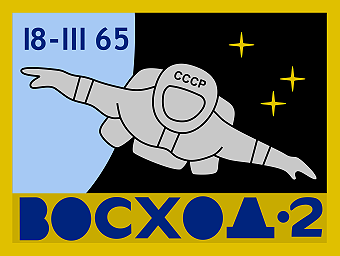 |
 |
![]()
Launch, orbit and landing data
walkout photo |
 |
||||||||||||||||||
alternative crew photo |
|||||||||||||||||||
alternative crew photo |
|||||||||||||||||||
alternative crew photo |
Crew
| No. | Surname | Given names | Position | Flight No. | Duration | Orbits | |
| 1 | Belyayev | Pavel Ivanovich | Commander | 1 | 1d 02h 02m 17s | 18 | |
| 2 | Leonov | Aleksei Arkhipovich | Second Pilot | 1 | 1d 02h 02m 17s | 18 |
Crew seating arrangement
|
 |
|
||||||||||||
1st Backup Crew
|
 |
|||||||||||||||
Hardware
| Launch vehicle: | Voskhod (No. R15000-05) |
| Spacecraft: | Voskhod 2 (3KD No. 4) |
Flight
|
Launch from the Baikonur Cosmodrome; landing
in the Ural-Mountains (180 km northeast of Perm, west of Berezniki). The Voskhod 2 spacecraft was a Vostok spacecraft with a backup, solid fuel retrorocket, attached atop the descent module. The ejection seat was removed and two seats were added, (at a 90-degree angle relative to the Vostok crew seats position). An inflatable exterior airlock was also added to the descent module opposite the entry hatch. After use, the airlock was jettisoned. There was no provision for crew escape in the event of a launch or landing emergency. A solid fuel braking rocket was also added to the parachute lines to provide for a softer landing at touchdown. This was necessary because, unlike the Vostok, the crew landed with the Voskhod descent module. On reaching orbit in Voskhod 2, Aleksei Leonov and Pavel Belyayev attached the EVA backpack to Aleksei Leonov’s Berkut (“Golden Eagle”) space suit, a modified Vostok Sokol-1 intravehicular (IV) suit. The white metal EVA backpack provided 45 minutes of oxygen for breathing and cooling. Oxygen vented through a relief valve into space, carrying away heat, moisture, and exhaled carbon dioxide. The space suit pressure could be set at either 40.6 kPa (5.89 psi) or 27.40 kPa (3.974 psi). Pavel Belyayev then deployed and pressurized the Volga inflatable airlock. The airlock was necessary because Vostok and Voskhod avionics were cooled with cabin air and would overheat if the capsule was depressurized for the EVA. The Volga airlock was designed, built, and tested in nine months in mid-1964. At launch, Volga fitted over Voskhod 2’s hatch, extending 74 cm (29 in) beyond the spacecraft's hull. The airlock comprised a 1.2 m (3.9 ft) wide metal ring fitted over Voskhod 2’s inward-opening hatch, a double-walled fabric airlock tube with a deployed length of 2.50 m (8.2 ft), and a 1.2 m (3.9 ft) wide metal upper ring around the 65 cm (26 in) wide inward-opening airlock hatch. Volga’s deployed internal volume was 2.50 m³ (88 cu ft). The fabric airlock tube was made rigid by about 40 airbooms, clustered as three, independent groups. Two groups sufficed for deployment. The airbooms needed seven minutes to fully inflate. Four spherical tanks held sufficient oxygen to inflate the airbooms and pressurize the airlock. Two lights lit the airlock interior, and three 16mm cameras — two in the airlock, one outside on a boom mounted to the upper ring — recorded the historic first spacewalk. Pavel Belyayev controlled the airlock from inside Voskhod 2, but a set of backup controls for Aleksei Leonov was suspended on bungee cords inside the airlock. Aleksei Leonov entered Volga, then Pavel Belyayev sealed Voskhod 2 behind him and depressurized the airlock. Aleksei Leonov opened Volga’s outer hatch and pushed out to the end of his 5.35 m (17.6 ft) umbilicus. He later said the umbilicus gave him tight control of his movements - an observation purportedly belied by subsequent American spacewalk experience. Aleksei Leonov reported looking down and seeing from the Straits of Gibraltar to the Caspian Sea. After Aleksei Leonov returned to his couch, Pavel Belyayev fired pyrotechnic bolts to discard the Volga. Sergei Korolev, Chief Designer at OKB-1 Design Bureau (now RKK Energia), stated after the EVA that Aleksei Leonov could have remained outside for much longer than he did, while Mstislav Keldysh, “chief theoretician” of the Soviet space program and President of the Soviet Academy of Sciences, said that the EVA showed that future cosmonauts would find work in space easy. After his 16 minutes outside the Voskhod, Aleksei Leonov found that his suit had stiffened to the point where he could not re-enter the airlock. He was forced to bleed off some of his suit's pressure, in order to be able to bend the joints. The two crewmembers subsequently experienced difficulty in sealing the hatch properly, followed by a troublesome re-entry in which malfunction of the automatic landing system forced the use of its manual backup. The spacecraft was so cramped that the two cosmonauts, both wearing spacesuits, could not return to their seats to restore the ship's center of mass for 46 seconds after orienting the ship for reentry. The orbital module did not properly disconnect from the landing module, causing the spacecraft to spin wildly until the modules disconnected at 100 km. The delay of 46 seconds caused the spacecraft to land 386 km from the intended landing zone, in the inhospitable forests of Upper Kama Upland, somewhere west of Solikamsk. Although mission control had no idea where the spacecraft had landed or whether Aleksei Leonov and Pavel Belyayev had survived. The two men were both familiar with the harsh climate and knew that bears and wolves, made aggressive by mating season, lived in the taiga; the spacecraft carried a pistol and "plenty of ammunition". Although aircraft quickly located the cosmonauts, the area was so heavily forested that helicopters could not land. Night arrived, the temperature fell to below -30°C and the spacecraft's hatch had been blown open by explosive bolts. Aleksei Leonov and Pavel Belyayev had to strip naked, wring out the sweat from their underwear, and redon it and the inner linings of their spacesuits to stay warm. A rescue party arrived on skis the next day with food and hot water, and chopped wood for a fire and a log cabin. After a more comfortable second night in the forest, the cosmonauts skied to a waiting helicopter several kilometers away and flew to Perm, then Baikonur. The capsule itself was recovered several days later. The recovery lasted double long, than the spaceflight. |
EVA data
| Name | Start | End | Duration | Mission | Airlock | Suit | |
| EVA | Leonov, Aleksei | 18.03.1965, 08:33 UTC | 18.03.1965, 08:49 UTC | 0h 16m | Voskhod 2 | Berkut | |
Photos / Graphics
 |
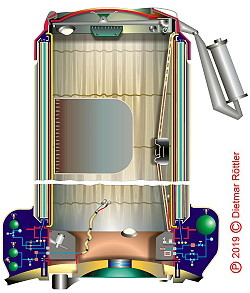 |
 |
 |
 |
 |
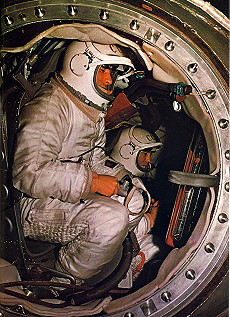 |
 |
 |
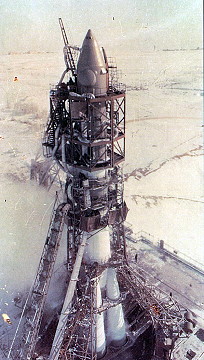 |
 |
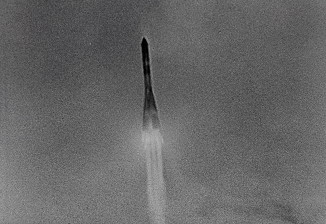 |
 |
 |
 |
 |
 |
 |
 |
 |
 |
 |
 |
| © |  |
Last update on August 12, 2020.  |
 |